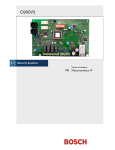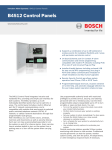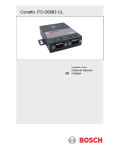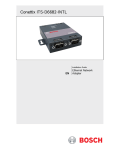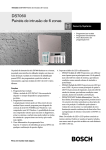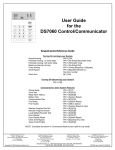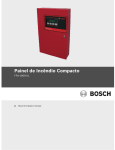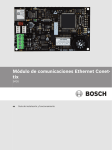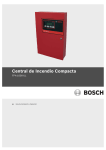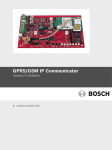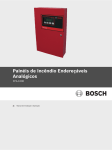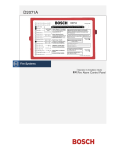Download Bolens 544 Lawn Mower User Manual
Transcript
Conettix C900V2 Installation Guide EN Dialer Capture Ethernet Module Conettix C900V2 | Installation Guide | Trademarks Trademarks ® Altronix is a registered trademark of Altronix Corporation. Phillips® is a registered trademark of Phillips Screw Company in the United States and other countries. Windows® 98, Windows® 2000, and Windows® XP, are registered trademarks of Microsoft Corporation in the United States and/or other countries. UL Listings and Approvals The Conettix C900V2 Dialer Capture Ethernet Module is UL Listed under the following standards: • UL Central Station Burglary (1610), Encrypted Line Security • UL Commercial Fire Alarm Signaling (864), Primary • UL Police Station Burglar Alarm Units and Systems (365) • FCC Part 15 Radiated/Conducted Emissions • cUL S304-M88, Central and Monitoring Station Burglar Alarm Units • C1076, Proprietary Burglar Alarm Units and Systems cUL installations approved for Level 3 Line Security when communicating over a packet-switched data network (PSDN). Install according to ULC-S302. Refer to the D6200 Software Operation and Installation Guide (P/N: 4998154991) for information on how to prepare the D6600 or D6100i in your Monitoring Center to receive UL Listed communications from a Conettix C900V2 Dialer Capture Ethernet Module. 2 Bosch Security Systems, Inc. | 8/08 | F01U087780-01 Conettix C900V2 | Installation Guide | Contents . Contents 1.0 2.0 2.1 2.1.1 2.1.2 2.1.3 2.2 2.3 2.4 2.5 2.6 2.7 3.0 3.1 3.2 3.3 3.3.1 3.3.2 3.5 4.0 Introduction..................................................4 Installation....................................................4 Mounting ...................................................... 4 Optional Mounting Plate............................... 4 Attaching the Module to the Enclosure Door 5 Separate Enclosure Mounting...................... 5 Wiring........................................................... 6 Input Functions ............................................ 7 Output Functions.......................................... 7 Power Terminal Strip ................................... 7 Telephone Connections ............................... 7 Ethernet Connection .................................... 8 Setup.............................................................8 Setting P3 .................................................... 8 Setting the DIP Switches.............................. 8 LEDs .......................................................... 10 System LED (LED 1).................................. 10 Dialer LED (LED 2) .................................... 10 Dialer Interaction........................................ 12 C900V2 Configuration Setup Instructions .................................................................... 13 4.1 Dynamic Host Configuration Protocol (DHCP) ................................................................... 13 4.2 Identifying the MAC Hardware Address ..... 13 4.3 Getting an IP Address ................................ 13 4.4 Initial IP Address Assignment Using ARP.EXE ................................................................... 13 4.5 Using Telnet to Finish the Configuration .... 14 4.5.1 Starting Windows 98SE, ME Telnet ........... 14 4.5.2 Starting Windows 2000/XP Telnet.............. 15 4.5.3 Configuration Using Telnet ........................ 16 5.0 Anti-Substitution Protection.................... 18 6.0 UL Standard 1610 and ULC S304 Intrusion System Installations................................. 19 6.1 Protected Premises Control Panel without Digital Dialer Backup.................................. 19 6.2 Protected Premises Control Panel with Digital Dialer Backup............................................. 22 7.0 UL Standard 864 for Fire System Installations............................................... 23 8.0 Specifications ........................................... 26 Appendix : C900V2 Compatible Data Formats ... 27 Bosch Security Systems, Inc. | 8/08 | F01U087780-01 Figures Figure 1: Figure 2: Figure 3: Figure 4: Figure 5: Figure 6: Figure 7: Figure 8: Figure 9: Figure 10: Figure 11: Figure 12: Figure 13: Location of Major Components .............. 4 Optional Mounting Plate ........................ 5 Attaching to Enclosure Door .................. 5 C900V2 in AE2 Enclosure ..................... 5 Wiring to a DS7400Xi in the Same Enclosure............................................... 6 C900V2 Input, Output, and Power ......... 7 RJ-11 Connector Wiring ........................ 7 C900V2 DIP Switches ........................... 8 C900V2 LED Locations ....................... 10 MAC Address Label Example .............. 13 ARP Table ........................................... 14 C900V2 and Generic Control Panel in Separate Enclosures (UL Standard 1610, with or without Telephone Line) ........... 20 C900V2 and Generic Control Panel in Separate Enclosures (UL Standard 864) ............................................................ 24 Tables Table 1: Table 2: Table 3: Table 4: Table 5: Table 6: Table 7: Table 8: Table 9: Table 10: Table 11: Table 12: Table 13: Power Terminal Functions ..................... 7 Control Panel and PSTN RJ-45 Connectors ............................................ 7 Ethernet Connector Pins........................ 8 Digital Dialer Protocol (DIP Switches 1 through 4, and 10) ................................. 9 DIP Switches 5 through 9 .................... 10 System LED Functions ........................ 11 Dialer LED Functions........................... 11 Dialer Interaction Forcing C900V2 into Fallback Mode ..................................... 12 Netmask Address ................................ 16 Connection Sequence – C900V2 and Generic Control Panel in Separate Enclosures (UL Standard 1610, with or without Telephone Line) ...................... 21 Connection Sequence – C900V2 and Generic Control Panel in Separate Enclosures (UL Standard 864)............. 25 Specifications ...................................... 26 Compatible Central Station Receiver Formats ............................................... 27 3 Conettix C900V2 | Installation Guide | Contents 1.0 Introduction 2.1 Mounting The C900V2 is static sensitive. Before handling the circuit board, touch earth ground to discharge any static electricity from your body. Use a grounding strap while installing the circuit board. The Conettix C900V2 Dialer Capture Ethernet Module (referred to as the C900V2) links the digital dialer (data output) from a control panel to an Ethernet connection on a local area network (LAN) or wide area network (WAN). When the dialer sends a message, the C900V2 simulates a public switched telephone network (PSTN) connection to the central station. The C900V2 decodes the digital dialer message and sends the decoded signals by Ethernet connection to the Conettix D6600 or D6100i. Communication Gateway/Receiver (referred to as the receiver). When the receiver acknowledges receipt of the message, the C900V2 sends an acknowledge message to the dialer. This process maintains true end-to-end security. The C900V2 has three modular connectors: • TELCO connects to the PSTN. • PANEL connects to a digital dialer. • Ethernet connects to the network. In Intercept Mode, the C900V2 connects the digital dialer to a LAN or WAN. In Fallback Mode, the C900V2 connects the dialer to the PSTN, which bypasses the C900V2 from the phone circuit. The C900V2 stays in Intercept Mode when its CPU is working (Output 1 open). In Fallback Mode, the C900V2 connects the dialer directly to the PSTN. The C900V2 switches to Fallback Mode if there is a CPU or network failure. 2.0 Installation Failure to follow these instructions can result in the system failing to transmit an alarm. Bosch Security Systems, Inc. is not responsible for improperly installed, tested, or maintained devices. Notify the central station and the local authority before installing the C900V2 in an existing system. Disconnect all power to the control panel before installing the C900V2. Figure 1: Location of Major Components 3 L 2 H 4 1 8 5 7 6 1 – RJ-45 phone jack (to PSTN) 2 – RJ-45 phone jack (to control panel) 3 – High and low voltage selector (refer to Section 3.1 on page 8) 4 – DIP switch (refer to Section 3.2 on page 8) 5 – RJ-45 Ethernet jack (to LAN or WAN) 6 – Power terminal strip (refer to Section 2.5 on page 7) 7 – Input and output wiring terminals (refer to Sections 2.3 and 2.4 on page 7) 8 – Dialer and system LEDs (refer to Section 3.3 on page 10) 2.1.1 Optional Mounting Plate Use an optional mounting plate (P/N: 40182) for mounting the C900V2 on the door of a control panel (D8103) or a fire control panel enclosure (D8109). You cannot use the D8108A Attack Resistant Enclosure. Mounting a C900V2 in a control panel enclosure is approved by UL only when used with a DS7400Xi as shown in Figure 5 on page 6. For the following procedure, refer to Figure 2 on page 5. 1. Insert the top hook of the supplied top (1) and bottom plastic standoffs (2) into the mounting plate brackets (3). Refer to Detail A. 2. Align the holes in the mounting brackets (3) and the plastic standoffs (1 and 2). 4 Bosch Security Systems, Inc. | 8/08 | F01U087780-01 Conettix C900V2 | Installation Guide | Contents . Figure 2: 2.1.3 Optional Mounting Plate Separate Enclosure Mounting You can mount the C900V2 in a separate enclosure such as the AE2. Refer to Figure 4. A 3 Mount the enclosure on a vertical surface before you install the C900V2 because the C900V2 covers one of the mounting holes (9). 1 3 6 2 4 5 6 3. Place the top edge of the C900V2 (4) under the standoff bracket of the top two standoffs (1). 4. Insert two of the Phillips® head screws provided (5) through the holes in the top standoffs (3). 5. Lower the bottom edge of the module to rest against the ledge of the two bottom standoffs (2). 6. Insert the other two Phillips head screws (5) into the bottom two mounting holes (6) on the C900V2 and through the bottom two plastic standoffs (2) and mounting bracket (3). 7. Tighten the screws until the C900V2 is attached securely to the mounting plate. 2.1.2 Attaching the Module to the Enclosure Door Refer to Figure 3. Figure 3: 1. Place the top edge of the C900V2 (1) between the two slots (2) on the inside top of the enclosure (3). 2. Insert the top hook of the top plastic standoffs (4) into the mounting brackets (5) on the back wall of the enclosure (6), showing a side view of the standoff in the mounting bracket). 3. Align the bottom two mounting holes (7) on the C900V2 with the plastic standoffs (4) and the enclosure mounting brackets (5). 4. Insert two screws (8) into the holes and slowly tighten until the C900V2 is secured firmly to the enclosure. Figure 4: C900V2 in AE2 Enclosure 8 1 2 3 7 4 Attaching to Enclosure Door 9 1 2 6 5 1. Slide the tabs (1) at the top of the mounting plate over the top lip of the enclosure door (2). 2. Position the mounting plate on the side farthest from the door hinge. Bosch Security Systems, Inc. | 8/08 | F01U087780-01 5 Conettix C900V2 | Installation Guide | Contents 2.2 Wiring Figure 5: Wiring to a DS7400Xi in the Same Enclosure 3 1 2 10 9 4 6 5 8 7 1– 2– 3– 4– C900V2 To LAN or WAN port DS7400Xi Control Panel Non-power limited area NOTE: All power limited wiring must be at least 6.4 mm (0.25 in.) from the battery wiring. You can use the C900V2 with a variety of control panels. The next sections provide information for wiring the C900V2 to a generic control panel. Refer to Figure 5. The control panel’s phone line monitor becomes inactive when the C900V2 intercepts the phone line between the telco service and the control panel. If phone line monitoring is required, use an external phone line monitor, such as the Bosch Security Systems, Inc. DS7481. 5 – Battery 6 – EOL resistor for the control panel, attached to terminals 7 – DS7481 Single Phone Line Monitor (optional) 8 – Telco jack 9 – RJ31X 10 – House telephone The DS7400Xi is the only control panel approved by UL to be wired in the same enclosure as the C900V2. You must install any other control panel in a separate enclosure to receive the UL approval. The loss of a network connection closes the Output 2 relay contact on the C900V2. You can connect this output to a 24-hour zone on the control panel. 6 Bosch Security Systems, Inc. | 8/08 | F01U087780-01 Conettix C900V2 | Installation Guide | . 2.3 Input Functions The C900V2 has three inputs monitored by analogto-digital (A/D) converters: • Input 1 (IN1): Used as an end-of-line (EOL) supervised loop. If input status reports are enabled by the receiver using the Conettix D6200 Programming/Administration Software (referred to as D6200 Software), any voltage below 1.66 VDC is sent as a short-circuit message to the D6600. Any voltage above 3.33 VDC is sent as an open-circuit message. Input 1 must be EOL-terminated with a 10 k resistor. Refer to the D6600/D6100i Computer Interface Manual (P/N: 4998122703) for Event Messages to automation software. • Input 2 (IN2): Used for Intercept Inhibit. If Input 2 rises above 5.5 VDC, the C900V2 is immediately forced into Fallback Mode for at least 2 minutes. Input 2 must go low for at least 5 seconds to be considered low. If Input 2 is not used, allow it to remain disconnected. • Input 3 (IN3): Used for Intercept Override. If Input 3 rises above 5.5 VDC for 5 seconds, the C900V2 enters Fallback Mode. If Input 3 goes low, the C900V2 returns to Intercept Mode. If this input is connected to a ground start relay output, the C900V2 remains in Intercept Mode, except to allow the dialer to dial. Input 3 cannot force Intercept Mode if the C900V2 is in Fallback Mode because of an error, a command, or a high signal at Input 2. If this input is not used, allow it to remain disconnected. You cannot use Inputs 1, 2 and 3 for UL Fire Listing. You can use the inputs for other purposes. Figure 6: C900V2 Input, Output, and Power 0V OUT4 OUT3 OUT2 OUT1 IN3 2.4 IN2 0V IN1 – V + • Output 2 (OUT2): Active (open) when the receiver works properly, and closed when the receiver does not respond to or acknowledge a message sent from the C900V2. Connect Output 2 from the C900V2 to a 24-hour zone on the control panel. This 24-Hour Zone Alarm Report enables the digital dialer, if used, to indicate or sound a failure if the network communications path fails. • Output 3 (OUT3): Active (open) when the C900V2 is in Intercept Mode. Output 4 (OUT4): Controlled by a command from the D6200 Software or receiver. The default is open. • 2.5 Power Terminal Strip Table 1: Terminal V (+) V (–) 2.6 Power Terminal Functions Description Connect regulated 12 to 24 VDC power to this terminal and the – V terminal. This power can be supplied by a separate power supply or auxiliary power from the control panel. 12 to 24 VDC return. Connect to earth ground. Telephone Connections Use two of the RJ-45 telephone connectors to connect to the control panel and to the PSTN. The connector pins are identified in Table 2 and Figure 7. Table 2: Pin 1 4 5 8 Control Panel and PSTN RJ-45 Connectors Connection T1 T R R1 Output Functions The C900V2 has four relay contact outputs: • Output 1 (OUT1): Active (open) when the CPU works properly. If the CPU fails or loses power, Output 1 closes. Connect Output 1 from the C900V2 to a 24-hour zone on the control panel. This 24-Hour Zone Alarm report enables the digital dialer, if used, to indicate or sound a failure if the C900V2 CPU fails. Bosch Security Systems, Inc. | 8/08 | F01U087780-01 Figure 7: RJ-11 Connector Wiring 8 1 1 7 Conettix C900V2 | Installation Guide | 3.0 2.7 Setup Ethernet Connection One of the RJ-45 jacks connects the C900V2 to the Ethernet Network (LAN or WAN). The connector pins are listed in Table 3. Table 3: Pin 1 2 3 6 Ethernet Connector Pins Connection TX+ TX– RX+ RX– 3.0 Setup 3.1 Setting P3 A shorting link on P3 selects the voltage and current applied to the alarm panel’s telephone circuit to simulate the signal from a PSTN telephone exchange. For most alarm panels, set the shorting link to the H position (short the middle and right pins of P3). The L position results in slightly lower power consumption for the C900V2 but some alarm panels might report a telephone line failure when dialing the C900V2. 3.2 Setting the DIP Switches A ten-position DIP switch programs the C900V2. The programming depends on the application and dialer format of the control panel connected to the module. Figure 8: 1 2 C900V2 DIP Switches 3 4 5 6 7 8 9 10 O N 1 2 1 – Off 2 – On Because the C900V2 emulates a phone line and a digital receiver, you must program the C900V2 to the format it receives from the control panel. DIP Switch positions 1 through 4 and 10 program the dialer format into the C900V2. Table 4 on page 9 lists the format programming for these DIP switches. For UL approved applications, the shorting link must be set to the H position. 8 Bosch Security Systems, Inc. | 8/08 | F01U087780-01 Conettix C900V2 | Installation Guide | 3.0 Setup . Table 4: Digital Dialer Protocol (DIP Switches 1 through 4, and 10) DIP Switches Dialer Format of Host Alarm Panel 10 1 2 3 4 ON OFF OFF OFF OFF Radionics Modem IIe and Modem IIIa2 ON OFF OFF OFF ON Radionics Modem II ON OFF OFF ON OFF DTMF* ON OFF OFF ON ON DTMF* (where dialer retransmits quickly) ON OFF ON OFF OFF BFSK (2300Hz ACK Tone) ON OFF ON OFF ON BFSK (1400Hz ACK Tone) ON OFF ON ON OFF FBI Superfast DTMF (2300 Hz ACK Tone) † ON OFF ON ON ON FBI Superfast DTMF (1400 Hz ACK Tone) † ON ON OFF OFF OFF Pulse 3/1, 3/1 Checksum (2300 Hz ACK Tone) ON ON OFF OFF ON Pulse 3/1, 3/1 Checksum (1400 Hz ACK Tone) ON ON OFF ON OFF Pulse 4/2 (Long 2300 Hz ACK Tone) ON ON OFF ON ON Pulse 4/2 (Long 1400 Hz ACK Tone) ON ON ON OFF OFF SIA Bell 103 (110/300 baud, 2016 Hz ACK Tone) ON ON ON OFF ON Reserved ON ON ON ON OFF ADT-SIA† ON ON ON ON ON Reserved OFF OFF OFF OFF OFF Reserved OFF OFF OFF OFF ON Reserved OFF OFF OFF ON OFF Scancom 481, 581, 681 †, ‡ OFF OFF OFF ON ON Reserved OFF OFF ON OFF OFF Reserved OFF OFF ON OFF ON Reserved OFF OFF ON ON OFF Telim † OFF OFF ON ON ON Robofon † OFF ON OFF OFF OFF Reserved OFF ON OFF OFF ON Reserved OFF ON OFF ON OFF Reserved OFF ON OFF ON ON Reserved OFF ON ON OFF OFF SIA Bell 103 (110/300 baud, 2083 Hz ACK Tone) † OFF ON ON OFF ON SIA V.21 (110/300 baud) † OFF ON ON ON OFF Seriee DTMF † OFF ON ON ON ON Seriee FSK † * DTMF includes Contact ID, High Speed and 4/2 Express † These formats have not been approved for UL 1610. ‡ Requires firmware version 1.12 or higher. Bosch Security Systems, Inc. | 8/08 | F01U087780-01 9 Conettix C900V2 | Installation Guide | 3.0 Table 5: Setup DIP Switches 5 through 9 Switch 5 6 73 8 9 1 2 3 4 State Function ON Enable auto Fallback Mode after detecting an intercept error.1 OFF Disable auto Fallback Mode after detecting an intercept error. ON Hang-ups do not cause Fallback Mode. OFF Third hang-up without receiver ACK causes Fallback Mode.2 ON 240 sec poll OFF 75 sec poll ON C900 sends initial handshake to panel after 6 sec dialing break. OFF C900 sends initial handshake to panel after 1 sec dialing break. ON Enable Anti-Replay/Substitution.4 OFF Disable Anti-Replay/Substitution. If an error occurs in the Intercept Mode, the C900V2 automatically returns (falls back) to the telco line. If the receiver does not acknowledge a report intercepted by the C900V2 in the specified time, the digital dialer hangs up and retries the message transmission. The C900V2 switches to Fallback Mode based on the number of hang-ups. The time that elapses between polls from the C900V2 when it is idle (not expecting a dialer acknowledgement). This DIP switch must be set to ON if the receiver is set up for NNC Mode. Any error forces the C900V2 to switch to Fallback Mode (phone line backup) for 2 min the next time the control panel seizes the line (if DIP Switch 5 is ON, DIP Switch 6 is OFF, or both, and if the control panel seizes the line within 2 min). Intercept errors are always reported to the receiver. If the receiver does not acknowledge a signal intercepted by the C900V2 in the specified time, the control panel digital dialer hangs up and tries to send the message again. 3.3 C900V2 LED Locations L H 1 2 LEDs The C900V2 has two dual-color status LEDs: the system LED and the dialer LED. The Ethernet connector also includes two LEDs that indicate the status of the network connection. The right LED lights or flashes when there is a valid connection to the network. 3.3.1 Figure 9: 3 1 – System LED 2 – Dialer LED 3 – Ethernet connector LEDs System LED (LED 1) The system LED indicates the status of the receiver and the C900V2 itself. Refer to Table 6 on page 11. 3.3.2 Dialer LED (LED 2) The dialer LED indicates the status of the digital dialer interface. Refer to Table 7 on page 11. 10 Bosch Security Systems, Inc. | 8/08 | F01U087780-01 Conettix C900V2 | Installation Guide | 3.0 Setup . Table 6: Color None Green System LED Functions State Off Solid Flashing (5 Hz) Solid Flashing (5 Hz) Flashing (Repeating Code) Alternating (5 Hz) Red Function No power. C900V2 failed. The receiver is responding normally. C900V2 failed. The receiver is not responding. 1 flash: ROM checksum error 2 flashes: RAM test error Red/ The dialer is off-hook, but the last message was rejected because of a bad checksum or Green other logical error.1 1 If the dialer subsequently sends a valid message, the LED returns to a blinking green status. If the dialer hangs up, an intercept error is generated. The alternating LED also occurs when the line is seized, but no transaction occurs (for example, the C900V2 is waiting for the dialer to return on-hook). This happens when the C900V2 returns to Intercept Mode, or while the dialer seizes the line. Table 7: Color None Green Dialer LED Functions State Off Solid Flashing (5 Hz) Solid Function C900V2 is in permanent Fallback Mode due to a command or no power. C900V2 is in Intercept Mode and the dialer is on-hook. C900V2 is in Intercept Mode and the dialer is off-hook. Red C900V2 is in Fallback Mode due to an error, Intercept Inhibit or Override inputs, or a command. Flashing (5 Hz) An off-hook condition caused an intercept error.1 Red/ Alternating (5 Hz) The dialer is off-hook, but the last message was rejected due to a bad checksum or other Green logical error.2 1 If Auto Fallback After Error is enabled (DIP Switch 5 = ON), the C900V2 connects the dialer to the phone line at the next line seizure. If the dialer does not seize the line, this condition terminates after two min. 2 If the dialer subsequently sends a valid message, the LED returns to a blinking green status. If the dialer hangs up, an intercept error is generated. The alternating LED also occurs when the line is seized, but no transaction occurs (for example, the C900V2 is waiting for the dialer to return on-hook). This happens when the C900V2 returns to Intercept Mode, or while the dialer seizes the line. Bosch Security Systems, Inc. | 8/08 | F01U087780-01 11 Conettix C900V2 | Installation Guide | 3.0 3.4 Setup 3.5 Fallback Mode In fallback operation, the C900V2 connects the PSTN directly to the dialer, bypassing itself from the phone circuit. Intercept Mode is maintained only if the C900V2 processor operates and there are no errors. Fallback Mode is ensured if a CPU lockup occurs. Table 8: Table 8 shows the conditions causing the C900V2 to change to Fallback Mode. The C900V2 returns to Intercept Mode only when all conditions in the Intercept Mode Restored column are met. Dialer Interaction Forcing C900V2 into Fallback Mode Condition CPU fails Receiver fails Receiver does not respond to last message Intercept Disable Command Intercept Error Switch to Fallback command 12 Dialer Interaction Fallback Mode Occurs Immediately Immediately Dialer goes off-hook (disconnected) Intercept Mode Restored C900V2 restart Link restored Link restored On receipt of the command If Fallback after intercept error is enabled, the dialer goes off-hook within two minutes of the error On receipt Intercept Enable command After two minutes One hour or at receipt of Intercept Enable command Bosch Security Systems, Inc. | 8/08 | F01U087780-01 Conettix C900V2 | Installation Guide | 4.0 C900V2 Configuration Setup Instructions . 4.0 C900V2 Configuration Setup Instructions 4.1 Dynamic Host Configuration Protocol (DHCP) The receiver can communicate with a C900V2 that has an IP address dynamically assigned by a DHCP server on the network. When using DHCP, you must set the receiver to use the network naming convention (NNC) to identify accounts instead of using static IP addresses. Devices in the field can have either a static IP address or a dynamic IP address. The receiver uses the NNC number to identify the account instead of the IP address. For devices having IP addresses assigned by a DHCP server: • Set DIP Switch 9 on the C900V2 to ON. • Enable NNC on the receiver. Refer to the D6600/D6100i Computer Interface Manual (P/N: 4998122702). • Set the Account Database in the D6200 Software to NNC Mode. Refer to the D6200 Programming Software Operation and Installation Guide (P/N: 4998154991). • Use the D6200 Software to enter the eight-digit NNC number located on the label of the C900V2 into the Account Database.. Refer to the D6200 Programming Software Operation and Installation Guide (P/N: 4998154991). • Configure network connections to communicate through a DHCP server. • Set the IP address of the C900V2 to 0.0.0.0. 4.2 Figure 10: MAC Address Label Example Identifying the MAC Hardware Address If you know the IP address of the configured C900V2, go to Section 4.5 Using Telnet to Finish the Configuration on page 14. You must program the IP address of the C900V2. The first step is to determine the MAC, or hardware, address of the C900V2. This address is hard-coded into the C900V2 during its manufacture and cannot be changed. This address is 6 bytes (12 digits) long. The MAC address label is located on the top of the Ethernet connector. Record this number for future reference. 4.3 Getting an IP Address If you are using Dynamic Host Configuration Protocol (DHCP), you do not need an IP address. If you are not using DHCP, request an IP address for your C900V2 from your network administrator. You might have to provide the MAC address. An IP address is an identifier for a computer or device on a TCP/IP network. The IP address is a 32-bit numeric address written as four numbers separated by periods. Each number can be zero to 255, for example, 190.200.128.111. In an isolated network, you can assign IP addresses at random if each one is unique. Connecting a private network to the Internet requires registered IP addresses (called Internet addresses) to avoid duplication. 4.4 Initial IP Address Assignment Using ARP.EXE The C900V2 you are configuring and the PC used to configure it must both be on the same gateway (the device that connects the LAN to the WAN) to use telnet for configuration of the C900V2. The gateway can be a router or a hub. After you configure the C900V2 and assign it an IP address, you can then use telnet to change configuration parameters from anywhere on the network. Read this entire procedure before starting. Ensure that power is applied to the C900V2 and the C900V2 is connected to the LAN or WAN through the Ethernet connector. Figure 10 shows an example of a MAC address. The following procedure shows how to use the ARP command to assign an IP address to the C900V2. Bosch Security Systems, Inc. | 8/08 | F01U087780-01 13 Conettix C900V2 | Installation Guide | 4.0 C900V2 Configuration Setup Instructions The IP and MAC addresses in this procedure are examples and are not the same as those for your C900V2. Figure 11: ARP Table 1. Select Start Æ Run. The Run dialog box appears. 2. In the Run dialog box, type COMMAND and click OK. A DOS window appears: 3. At the DOS command line, type: arp -s xxx.xxx.xxx.xxx zz-zz-zz-zz-zz-zz and press [ENTER]. • • xxx.xxx.xxx.xxx is the IP address the network administrator assigned to the C900V2 zz-zz-zz-zz-zz-zz is the MAC address printed on the Ethernet connector label. For example: The network uses this table to identify devices and to route signals. The number of devices and other types (static and dynamic, as shown in the example) depends on the network and the number and type of devices with which this PC communicates. Identify the MAC address of the device you are installing and verify that it now has an IP address linked to it. 4.5 Using Telnet to Finish the Configuration Use the telnet program to configure the C900V2. The procedure for Windows 98SE, ME is different from the procedure for Windows 2000 and Windows XP. 4.5.1 Starting Windows 98SE, ME Telnet 1. Select Start Æ Run. The Run dialog box appears. 2. In the Run dialog box, type telnet and press [ENTER]. The Telnet application window appears. The program responds with a prompt to indicate that the address was accepted. 3. Select Connect Æ Remote System. The program does not indicate that the operation was performed properly. The only indication is the absence of an error message. The Connect dialog box appears. 4. Verify that you entered the IP address correctly. Type: arp -g and press [ENTER]. This command displays the IP address 172.17.10.70 temporarily linked to MAC address 00-20-4a-12-04-0e as shown in Figure 11. The temporary link shows a static entry. 14 a. In the Host Name field, type the IP address of the C900V2. b. In the Port, field type 1. c. Accept vt100 as the TermType field. d. Click Connect. Bosch Security Systems, Inc. | 8/08 | F01U087780-01 Conettix C900V2 | Installation Guide | 4.0 C900V2 Configuration Setup Instructions . After a few seconds, an error message appears. 4. Click OK to clear the message. The Telnet window appears again. 5. Select Connect Æ Remote System. The Connect dialog box appears again. Continue with Section 4.5.3 Configuration Using Telnet on page 16. 4.5.2 Starting Windows 2000/XP Telnet To do this procedure, you must log in at an administrator privilege level. 6. This time, change the Port field to 9999, accept the other fields, and click Connect. This message appears. The MAC address, IP address, gateway IP address, and port number in this procedure are examples and are not the same as those for your C900V2. 1. Select Start Æ Run. The Run dialog box appears. 2. In the Run dialog box, type telnet and click OK. 7. Press [ENTER]. The Telnet window appears. You must press [ENTER] within five seconds or the telnet session disconnects. The Telnet window shows this information. 3. Type open <IP ADDRESS> 1 and press [ENTER] (where <IP ADDRESS> is the IP address of the C900V2). Type a space after open and after the IP address. For example: open 172.17.10.70 1. The connection fails the first time. This is normal. Repeat the previous step using 9999 as the port number: 4. Type open <IP ADDRESS> 9999 and press [ENTER] (for example, open 172.17.10.70 9999). Bosch Security Systems, Inc. | 8/08 | F01U087780-01 15 Conettix C900V2 | Installation Guide | 4.0 C900V2 Configuration Setup Instructions 5. Press [ENTER]. The Setup Mode information appears. Continue with Section 4.5.3 Configuration Using Telnet. 4.5.3 Configuration Using Telnet 1. Type 0 (zero) and press [ENTER] to set up the basic server configuration. If the C900V2 was previously programmed with an IP address, the address appears in parentheses. 2. Type the IP address (for example, 190.200.128.219) and press [ENTER]. If you are using DHCP type 0.0.0.0 and press [ENTER]. Refer to Section 4.1 Dynamic Host Configuration Protocol (DHCP) on page 13. 3. If the Gateway address is required, type y, press [ENTER] and then type the address and press [ENTER]. If the Gateway address is not required or if you use DHCP, type n and press [ENTER] This prompt appears. The Gateway IP is required only if you are connecting to a WAN. In a LAN, the Gateway IP is usually not needed unless the Gateway IP of the PC is different from the Gateway to which the C900V2 is connected. 4. If using DHCP, press [ENTER]. If not, enter the number of bits that correspond to the netmask your network uses and press [ENTER]. Refer to Table 9. Contact your network administrator if you need more information about the netmask. 16 Table 9: Host Bits 1 2 3 4 5 6 7 8 9 10 11 12 13 14 15 16 Netmask Address Netmask 255.255.255.254 255.255.255.252 255.255.255.248 255.255.255.240 255.255.255.224 255.255.255.192 255.255.255.128 255.255.255.0 255.255.254.0 255.255.252.0 255.255.248.0 255.255.240.0 255.255.224.0 255.255.192.0 255.255.128.0 255.255.0.0 Host Bits 17 18 18 20 21 22 23 24 25 26 27 28 29 30 31 Netmask 255.254.0.0 255.252.0.0 255.248.0.0 255.240.0.0 255.224.0.0 255.192.0.0 255.128.0.0 255.0.0.0 254.0.0.0 252.0.0.0 248.0.0.0 240.0.0.0 224.0.0.0 192.0.0.0 128.0.0.0 If you are using DHCP, this prompt appears. 5. If you do not want to assign or change the name, press [ENTER]. If you want to assign a name for this device for use on a LAN, type y and press [ENTER}. Type the name, up to 16 characters, and press [ENTER]. If you do not enter a DHCP device name, a default name of Cxxxxxx is used (where xxxxxx is the last six digits of the MAC address). This prompt appears. 6. Press [ENTER] to accept the password setting at none. In most cases, do not assign a password. If a password is necessary, store it in a safe place. If you lose or forget the password, you cannot connect to C900V2 using telnet until you send the unit to the factory for password removal, and the unit is returned to you. The Setup Mode information appears. Bosch Security Systems, Inc. | 8/08 | F01U087780-01 Conettix C900V2 | Installation Guide | 4.0 C900V2 Configuration Setup Instructions . 15. Type the Port Number for the receiver and press [ENTER]. If you want to enable encryption, continue with the next step. If not, go to step 27. If you enable encryption on the C900V2, you must enable encryption on the D6680 with the same key. 16. From the Change Setup menu, type 6 and press [ENTER]. This information appears. 7. Type 1 and press [ENTER] to set up Channel 1 configuration. This information appears. 8. 9. 10. 11. 12. 13. 14. If the default value displayed in your Telnet window does not match the value listed in any of the steps below, type the correct value and press [ENTER]. At the Baud Rate prompt, press [ENTER] to accept the default (9600). At the I/F Mode prompt, press [ENTER] to accept the default (4C). At the Flow prompt, press [ENTER] to accept the default (00). Type a unique Port Number for the LAN to which the C900V2 is connected and press [ENTER]. At the ConnectMode prompt, press [ENTER] to accept the default (CC). At the Datagram Type prompt, type 01 and press [ENTER]. At the IP addr prompt, type the remote IP address used for the receiver to which the C900V2 reports and press [ENTER]. Enter the remote IP address using 000.000.000.000 format. Bosch Security Systems, Inc. | 8/08 | F01U087780-01 17. At the Disable SNMP prompt, press [ENTER] to accept the default (N). 18. At the SNMP Community Name prompt, press [ENTER] to accept the default (public). 19. At the Disable Telnet Setup prompt, press [ENTER] to accept the default (N). 20. At the Disable Port 77FEh prompt, press [ENTER] to accept the default (N). 21. 22. 23. 24. 25. Disabling both the telnet and port 77FE prevents you from accessing the set-up menu for future changes. At the Disable Web Server prompt, press [ENTER] to accept the default (N). At the Disable ECHO ports prompt, press [ENTER] to accept the default (Y). At the Enable Encryption prompt, type y and press [ENTER]. At the Change keys prompt, type y and press [ENTER]. Type the key programmed for the receiver and press [ENTER]. The key is 16 bytes (32 characters) long. Enter the key using the 01-02-03-04-05-06-07-08-0910-11-12-13-14-15-16 format. 26. At the Enable Enhanced Password prompt, press [ENTER] to accept the default (N). 27. Type 9 and press [ENTER] to save changes and exit the telnet session. To confirm that the IP address is configured properly, use the ping utility: 17 Conettix C900V2 | Installation Guide | 5.0 Anti-Substitution Protection 28. At the C:\> prompt, type ping <IP Address> and press [ENTER]. Four reply messages are received, confirming the C900V2 is communicating on the network. Configuration of the C900V2 is complete. 18 5.0 Anti-Substitution Protection 1. Remove power from the C900V2. 2. Set DIP Switch 9 to the ON position (the factory default). Refer to Section 3.2 Setting the DIP Switches on page 8. 3. Apply power to the C900V2. After rebooting the C900V2, the unit exchanges numeric keys with the receiver, and they become synchronized. Once they are synchronized, all subsequent communications sessions numerically validate the authenticity of the sender and receiver. Each session generates an entirely new set of keys, which invalidates the replay of authentic sessions. Bosch Security Systems, Inc. | 8/08 | F01U087780-01 Conettix C900V2 | Installation Guide | 6.0 UL Standard 1610 and ULC S304 Intrusion System Installations . 6.0 UL Standard 1610 and ULC S304 Intrusion System Installations 5. Connect Output 1 from the C900V2 to a 24-hour zone on the control panel. To install the C900V2 to comply with UL Standard 1610 Applications (for Line Security, formerly “Grade AA”) and ULC S304, you must satisfy all requirements in this section. 6. Connect Output 2 from the C900V2 to a 24-hour zone on the control panel. 6.1 Protected Premises Control Panel without Digital Dialer Backup 1. Use the D6200 Software to set the poll rate on the C900V2. For UL approved installations, the maximum interval is 90 seconds to meet the requirement for polling supervision established by UL. In most cases, to get a polling supervision interval of 90 seconds, set the Poll Rate to 75 and Retry to 13. Because of differences in packet transmission time latency within different networks, the poll rate times vary. Contact Technical Support at Bosch Security Systems, Inc. for assistance in establishing the latency time for the network on which you are installing the C900V2. Refer to D6200 Software Operation and Installation Guide (P/N: 4998154991). 2. Set DIP Switch 7 to the OFF position to enable 75-second supervision signals (the factory default). Refer to Table 5 on page 10 for the functions of DIP Switches 5 through 9. 3. Add a telnet password to the communications protocol of the C900V2 (refer to Section 4.5.3 Configuration Using Telnet, step 6, on page 16). Retain this password for future reference. 4. Program the control panel to send a daily test signal through the digital dialer. This enables the control panel to locally annunciate a C900V2 CPU failure. This enables the control panel to locally annunciate a network failure. You must use the C900V2 with a UL Listed Burglary Alarm Control Unit or a UL Listed combination Fire/Burglary Alarm Control Unit with an integral or Listed digital alarm communicator transmitter (DACT) installed according to the manufacturer’s instructions. 7. Install a tamper switch (such as a D110 Tamper Switch, available from Bosch Security Systems, Inc.) on the control panel enclosure and connect it to a 24-hour zone on the control panel. If you use a separate enclosure for the C900V2, install another tamper switch (D110) on the enclosure and connect it to the same 24-hour zone. 8. Set DIP Switch 5 to OFF to disable Auto Fallback. 9. Set DIP Switch 6 to ON to prevent fallback caused by hang-ups. Intercept errors are reported to the receiver. If the receiver does not acknowledge a signal sent that was intercepted by the C900V2 in the programmed time, the control panel digital dialer hangs up and retries the message transmission. 10. Set DIP Switch 9 to ON to enable AntiSubstitution/Anti-Replay. 11. Set the shorting link on P3 to the H position. Refer to Figure 12 on page 20 and Table 10 on page 21 for the proper connection sequence. This tests the connection from the control panel to the C900V2. Bosch Security Systems, Inc. | 8/08 | F01U087780-01 19 Conettix C900V2 | Installation Guide | 6.0 UL Standard 1610 and ULC S304 Intrusion System Installations Figure 12: C900V2 and Generic Control Panel in Separate Enclosures (UL Standard 1610, with or without Telephone Line) 1 3 PANEL 1 2 3 4 5 6 7 8 9 10 O F F 2 TELCO 1 6 2 7 4 8 5 9 6 11 5 4 3 3 7 9 10 14 15 13 12 + - 6 8 1– 2– 3– 4– 5– Optional telephone line C900V2 D110 Tamper Switch LAN or WAN Metal conduit no longer than 6.1 m (20 ft) 6– 7– 8– 9– AE2 enclosure Host control panel Battery AC transformer indicates the connection sequence. Refer to Table 10. 20 Bosch Security Systems, Inc. | 8/08 | F01U087780-01 Conettix C900V2 | Installation Guide | 6.0 UL Standard 1610 and ULC S304 Intrusion System Installations . Table 10: Seq 1 2 3 4 5 6 7 8 Connection Sequence – C900V2 and Generic Control Panel in Separate Enclosures (UL Standard 1610, with or without Telephone Line) C900V2 Connection RJ-45 PANEL connector RJ-45 ETHERNET connector – V terminal V+ Install an EOL resistor for the control panel across OUT2-L and OUT1-R OUT2-L TO OUT1-L OUT2-R TO OUT1-R OUT1-R Control Panel Connection to to RJ-45 connector (telco dialer) to to –12 to –24 VDC (common) +12 to +24 VDC output Other Connection LAN or WAN to 9 10 24-hour zone input common 11 OUT2-L to 24-hour zone input 12 Battery negative input 13 Battery positive input 14 AC input 15 AC input NOTE: The sequence numbers appear in the diagram in Figure 12. to to to C900V2 enclosure closed-circuit tamper switch C900V2 enclosure closed-circuit tamper switch to control panel enclosure closed-circuit tamper switch Control panel enclosure closedcircuit tamper switch Battery negative terminal Battery positive terminal AC transformer AC transformer The optional telephone line is for programming and diagnostics only. Bosch Security Systems, Inc. | 8/08 | F01U087780-01 21 Conettix C900V2 | Installation Guide | 6.0 6.2 UL Standard 1610 and ULC S304 Intrusion System Installations Protected Premises Control Panel with Digital Dialer Backup 1. Use the D6200 Software to set the poll rate on the C900V2. For UL approved installations, the maximum interval is 360 seconds to meet the requirement for polling supervision established by UL. In most cases, to get a polling supervision interval of 360 seconds, set the Poll Rate to 240 and Retry to 13. Because of differences in packet transmission time latency within different networks, the poll rate times vary. Contact Technical Support at Bosch Security Systems, Inc. for assistance in establishing the latency time for the network on which you are installing the C900V2. Refer to D6200 Software Operation and Installation Guide (P/N: 4998154991). 2. Set DIP Switch 7 to the ON position to enable 240-second supervision signals. Refer to Table 5 on page 10 for the functions of DIP Switches 5 through 9. 3. Add a telnet password to the communications protocol of the C900V2 (refer to Section 4.5.3 Configuration Using Telnet, step 6, on page 16). Retain this password for future reference. 4. Program the control panel to send a daily test signal through the digital dialer. This tests the connection from the control panel to the C900V2. 5. Connect Output 1 from the C900V2 to a 24-hour zone on the control panel. This tests the digital dialer if the C900V2 CPU fails. 6. Connect Output 2 from the C900V2 to a 24-our zone on the control panel. This tests the digital dialer if the network communications path supervision fails. You must use the C900V2 with a UL Listed Burglary Alarm Control Unit or a UL Listed combination Fire/Burglary Alarm Control Unit with an integral or Listed digital alarm communicator transmitter (DACT) installed according to the manufacturer’s instructions. 7. Install a tamper switch (such as a D110 Tamper Switch, available from Bosch Security Systems, Inc.) on the control panel enclosure and connect it to a 24-hour zone on the control panel. If you use a separate enclosure for the C900V2, install another tamper switch (D110) on the enclosure and connect it to the same 24-hour zone. 8. Set DIP Switch 5 to ON to enable Auto Fallback. 9. Set DIP Switch 6 to OFF so three hang-ups cause fallback. Any error forces the C900V2 to switch to Fallback Mode for 2 minutes the next time the alarm panel seizes the line (if DIP Switch 5 is ON or DIP Switch 6 is OFF, or both, and the seizure occurs within 2 minutes). Intercept errors are always reported to the receiver. If the receiver does not acknowledge the signal in the programmed time, the control panel digital dialer hangs up and retries the message. 10. Set DIP Switch 9 to ON to enable AntiSubstitution/Anti-Replay. 11. Set the shorting link on P3 to the H position. Refer to Figure 12 on page 20 and Table 10 on page 21 for the proper connection sequence. 22 Bosch Security Systems, Inc. | 8/08 | F01U087780-01 Conettix C900V2 | Installation Guide | 7.0 UL Standard 864 for Fire System Installations . 7.0 UL Standard 864 for Fire System Installations To install the C900V2 in compliance with UL 864 for Fire System Installations, you must satisfy all requirements in this section. You must install the system in accordance with NFPA-72. If the control panels are used for fire applications, test according to NFPA-72. For UL Listed Fire Installations, shared on-premises communications equipment must be UL Listed for Information Technology Equipment. Installation at the Protected Premises 1. Use the D6200 Software to set the poll rate on the C900V2. For UL approved installations, the maximum interval is 90 seconds to meet the requirement for polling supervision established by UL. In most cases, to get a polling supervision interval of 90 seconds, set the Poll Rate to 75 and Retry to 13. (For non-UL approved installations, the maximum interval is 300 seconds to meet the requirement for polling supervision set by NFPA Standard 72, Section 5-5.4.4.1. To get a polling supervision interval of 300 seconds, set the Poll Rate to 240 and Retry to 13.) Because of differences in packet transmission time latency within different networks, the poll rate times vary. Contact Technical Support at Bosch Security Systems, Inc. for help in establishing the latency time for the network on which you are installing the C900V2. Refer to D6200 Software Operation and Installation Guide (P/N: 4998154991). 2. Set DIP Switch 7 to the OFF position to enable 75-second supervision signals. Refer to Table 5 on page 10 for the functions of DIP Switches 5 through 9. 3. Add a telnet password to the communications protocol of the C900V2 (refer to Section 4.5.3 Configuration Using Telnet, step 6, on page 16). Retain the password for future reference. Bosch Security Systems, Inc. | 8/08 | F01U087780-01 4. Program the control panel to send a daily test signal through the digital dialer. This tests the connection from the control panel to the C900V2. 5. Connect Output 1 from the C900V2 to a 24-hour zone on the control panel. This enables the control panel to annunciate a C900V2 CPU failure locally. 6. Connect Output 2 from the C900V2 to a 24-hour zone on the control panel. This enables the control panel to annunciate a network failure locally. You must use the C900V2 with a UL Listed Fire Alarm Control Unit or a UL Listed combination Fire/Burglary Alarm Control Unit with an integral or UL Listed digital alarm communicator transmitter (DACT). Refer to the C900TTL-E and C900V2 Compatibility Chart (P/N: 4998141056). 7. If the C900V2 is installed in a separate enclosure, you must locate the unit in the same room within 6.1 m (20 ft) because the control equipment and the wiring must be enclosed in conduit (or equivalently protected against mechanical injury). Mounting a C900V2 in a control panel enclosure is approved by UL only when used with a DS 7400Xi as shown in Figure 5 on page 6. 8. You must use the C900V2 with a UL Listed Power Supply (such as Altronix® AL300ULXR). 9. Set DIP Switch 5 to OFF to disable Auto Fallback. 10. Set DIP Switch 6 to ON to prevent fallback caused hang-ups. Intercept errors are reported to the receiver. If the receiver does not acknowledge a signal sent that was intercepted by the C900V2 in the programmed time, the control panel digital dialer hangs up and retries the message transmission. 11. Set DIP Switch 9 to ON to enable AntiSubstitution/Anti-Replay. 12. Set the shorting link on P3 to the H position. Refer to Figure 13 on page 24 and Table 11 on page 25 for the proper connection sequence. 23 Conettix C900V2 | Installation Guide | 7.0 UL Standard 864 for Fire System Installations Figure 13: C900V2 and Generic Control Panel in Separate Enclosures (UL Standard 864) 1 3 PANEL 1 2 3 4 5 6 7 8 9 10 O F F 2 TELCO 1 3 11 9 2 6 5 8 7 10 6 12 14 10 4 11 4 10 5 3 7 13 9 17 18 16 15 + - 6 8 1– 2– 3– 4– 5– 6– Optional telephone line C900V2 D110 Tamper Switch LAN or WAN Metal conduit no longer than 6.1 m (20 ft) AE2 enclosure 7 – Host control panel 8 – Battery 9 – AC transformer 10 – Battery 11 – UL Listed power supply (such as Altronix AL300-ULXR) in separate enclosure indicates the connection sequence. Refer to Table 11. 24 Bosch Security Systems, Inc. | 8/08 | F01U087780-01 Conettix C900V2 | Installation Guide | 7.0 UL Standard 864 for Fire System Installations . Table 11: Seq 1 2 3 4 5 Connection Sequence – C900V2 and Generic Control Panel in Separate Enclosures (UL Standard 864) C900V2 Connection Control Panel Connection RJ-45 PANEL connector RJ-45 ETHERNET connector – V terminal V+ to to to to Install an EOL resistor for the control panel across OUT2-L and OUT1-R OUT2-L to OUT1-L OUT2-R to OUT1-R OUT1-R to Other Connection RJ-45 connector (telco dialer) LAN or WAN –12 to –24 VDC (common) +12 to +24 VDC output Power supply +BAT input to battery 1 + terminal Power supply –BAT input to battery 2 – terminal Battery 1 – terminal to battery 2 + terminal (in series) 6 7 8 9 10 11 12 13 24-hour zone input common 14 OUT2-L to 24-hour zone input 15 Battery negative input 16 Battery positive input 17 AC input 18 AC input NOTE: The sequence numbers appear in the diagram in Figure 13. Bosch Security Systems, Inc. | 8/08 | F01U087780-01 to to to C900V2 enclosure closed-circuit tamper switch C900V2 enclosure closed-circuit tamper switch to control panel enclosure closed-circuit tamper switch Control panel enclosure closedcircuit tamper switch Battery negative terminal Battery positive terminal AC transformer AC transformer 25 Conettix C900V2 | Installation Guide | 8.0 Specifications 8.0 Specifications Table 12: Specifications Voltage Range Current Dimensions Operating Temperature Connectors: Control Panel Telco LAN/WAN Ethernet Cable Input Protocol (from control panel) Output Protocol (to LAN/WAN) Ringer Equivalency Number Interface Outputs 26 12 VDC to 24 VDC, nominal 280 mA, maximum 17.8 cm x 11.4 cm (7 in. X 4.5 in.) 0º C to 49º C (32º F to 120º F) RJ-45 modular jack RJ-45 modular jack RJ-45 modular jack Category 3 or better (10 BaseT) or Category 5 or better (100 Base-T), unshielded twisted pair, 100 m (328 ft) maximum Refer to Table 4 on page 9. UDP/IP packets 0.0 B IEEE 802.3 Relay contact type Bosch Security Systems, Inc. | 8/08 | F01U087780-01 Conettix C900V2 | Installation Guide | Appendix : C900V2 Compatible Data Formats . Appendix : C900V2 Compatible Data Formats Table 13: Compatible Central Station Receiver Formats Compatible Receiver Formats Receive r Model D6600 D6100i Radionics Modem Iie, II and IIIa2 Radionic s BFSK SIA Bell 103, 110 & 300 baud Pulse 3/1 3/1 4/2 Checksum DTMF Contact ID X X X X X X X X X X Bosch Security Systems, Inc. | 8/08 | F01U087780-01 X X X X Ademco High Speed X X Ademco 4/2 Express X X 27 Bosch Security Systems, Inc. 130 Perinton Parkway Fairport, NY 14450-9199 (800) 289-0096 © 2008 Bosch Security Systems, Inc. F01U087780-01




























